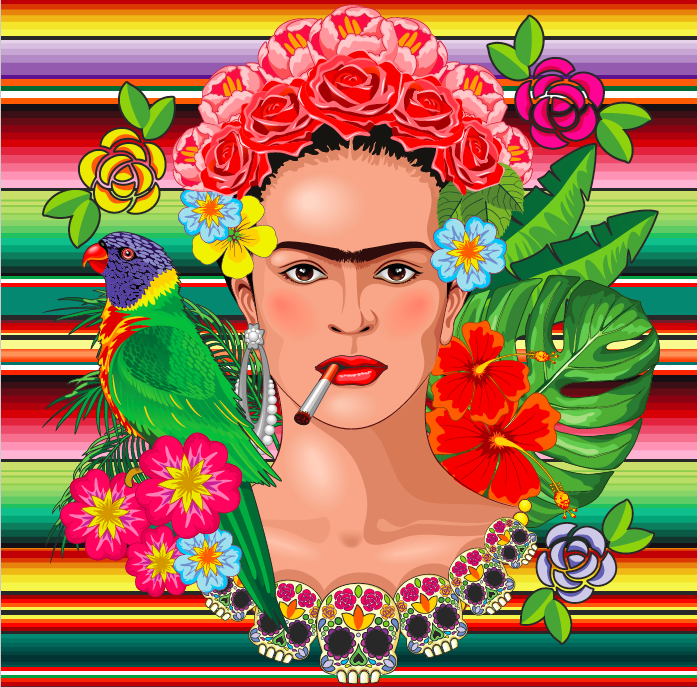In recent years, queer Latinas have been enjoying more and more visibility in popular culture. We have shows like “Vida,” created by a queer Latina about queer Latinas. We have Latina supermodels like Patricia Velazquez coming out in their autobiographies. We have openly queer Afro-Latinas competing in beauty pageants in the freaking South! But we likely wouldn’t have as many wonderful bi, lesbian, and trans Latinas waving their rainbow flags high had it not been for the incredible and courageous queer Latinas of the past. Let’s give it up for the beautiful, badass Mujeres that paved the way so many years ago for folks like you and me to be out and proud today.
Chavela Vargas
Chavela Vargas was a woman who lived life by her own code. Born in Costa Rica, Vargas ran away to Mexico as a teenager and made a name for herself playing guitar and singing rancheras — traditional Mexican songs that were predominantly sung by men. Vargas didn’t care for convention though. In her youth, she dared to dress in men’s clothing, drank, and smoked with the best of them. The street performer eventually gained notoriety among artist circles, befriending many including Frida Kahlo, whom she also allegedly had an affair with.
Despite taking a lengthy music hiatus due to alcoholism, Vargas recorded dozens of albums throughout her life and even won a Latin Grammy award. While many already assumed or knew about her sexuality, the accomplished chanteuse didn’t actually come out as a lesbian to the world until the publication of her autobiography, “Y Si Quieres Saber De Mi Pasado,” in the early 2000s. Vargas passed away at the age of 93 and no doubt left behind a memorable imprint on the world.
Frida Kahlo
When speaking of queer Latinas of the past, there is none as popular as the artist Frida Kahlo. Yes, she was married to fellow painter Diego Rivera, but we all know that there was way more to Kahlo than that particular relationship. The Mexican queen of “selfies,” Kahlo never had what you’d call an easy life. As a child, she fell ill with Polio, which left her with limp. Then at 18, she was in a bus accident in which she was impaled by a handrail. She needed several surgeries due to her injuries, which included pelvic and spinal fractures, but Kahlo never fully recovered, forcing her to live with chronic pain and infertility issues, including numerous miscarriages.
Fortunately, Kahlo used painting as a way to deal with her tragedy. She had her first solo exhibition in NYC in the late 1930s, then another in Paris. She would become the first Mexican artist to sell their work to the Louvre. Throughout her marriage to Rivera, they both had several extramarital affairs — with Kahlo taking on both male and female lovers. Among her most notable lovers was the singer and dancer Josephine Baker, whom she spent time with while in Paris. Frida also had no problem with bending gender norms at the time, often donning men’s suits. Sadly, Frida passed away at the young age of 47 due to declining health issues, but I like to imagine she’s enjoying the company of so many other amazing ladies in the afterlife.
Gloria Evangelina Anzaldua
Gloria Anzaldua is one of the most well-known queer Latina writers and scholars of all time. Born and raised in the Texas borderlands, Anzaldua spent her life speaking on and writing about feminist theory, often tackling the intersections of queerness and Chicana identity. Anzaldua worked as a school teacher, professor, and activist while also authoring and editing several books. Among her most notable works are “Borderlands/La Frontera: The New Mestiza,” and the collection “This Bridge Called My Back: Writings by Radical Women of Color,” which she co-edited alongside another notable queer Latina, Cherrie Moraga.
Throughout her life, she is reported to have had relationships with both women and men but mainly identified as a lesbian. Anzaldua won several notable awards throughout her life, including the NEA Fiction Award and the Lambda Lesbian Small Book Press Award. She passed away in 2004 due to complications related to diabetes.
Sylvia Rivera
Sylvia Rivera was a prominent fixture in the gay liberation and trans rights movement in New York City from the late 1960s and beyond. Born and raised in the city and of Venezuelan and Puerto Rican descent, Rivera was notably among those present at the Stonewall Riots in 1969 and was a close friend of Marsha P. Johnson.
The following year, the pair would found the Street Transvestite Action Revolutionaries (STAR), a group that helped drag queens, trans women, and gay youth who were homeless. Rivera was particularly passionate about helping such people as she herself was taken in off the streets by drag queens. Throughout her life, Rivera fought relentlessly to ensure that trans folks’ rights were protected.
Nancy Cardenas
Nancy Cardenas may not be a household name, but she is most notable for being among the first queer women to come out on national television in her homeland. The Mexican playwright, poet, and actor began her career as a radio announcer in her 20s. She switched to acting and then writing (plays as well as traditional journalism) in the 1960s. In the following decade, she would switch to directing theater. It was then that she would out herself as a lesbian during an on-air interview — a monumental moment in Mexican and queer history.
Cardenas would go on to help form the Frente de Liberacion Homosexual Mexicano, the first gay organization in Mexico, in 1974. The following year, she co-wrote the Manifesto in Defense of Homosexuals in Mexico, and sometime after that, helped organize the first LGBTQ+ pride march in the country. Cardenas was a true activist and a hero for us all to look up to.


What Do You Think?